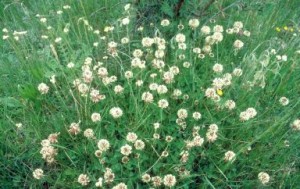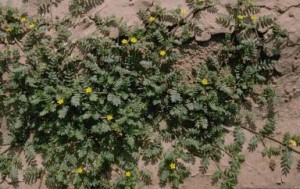CITY WEEDS: MANAGING PESKY INVADERS
IN AN URBAN LANDSCAPE
| Printable Version |
By Cheryl A Wilen, Ph.D., the Weed Science Society of America
You might think weeds are only a problem on farms or in suburban communities with wide-open spaces. But they also plague urban landscapes — from our children’s schoolyards and the public parks where we picnic and play…to roadsides, abandoned lots and urban “natural” areas.
When left unchecked along fences, weeds can trap unsightly trash and debris. Weeds sprouting through cracks on a basketball court, parking lot or walking path can accelerate the costly breakdown of pavement — especially in cold climates where water can enter the widening cracks and freeze. Along roadsides, weeds can promote accidents by hindering visibility for drivers, bikers and pedestrians.
Unfortunately some weeds can also impact human health. A few examples: Flowering white clover (Trifolium repens) can lead to bee stings when it infests schoolyards or other public venues. Poison oak (Toxicodendron diversilobum) and poison ivy (Toxicodendron radicans) can expose walkers and runners using public paths to rash-producing oils. Runaway ragweed (Ambrosia artemisiifolia) can cause dripping noses and itchy eyes. Football players in one urban California community experienced scratches and painful skin punctures when their local football field became infested with puncturevine (Tribulus terrestris), a prostrate weed with very spiny seedpods.
What’s the best way to manage urban weeds? There are a number of potential solutions — some more effective in a city environment than others.
One approach is to use herbicides appropriate to the weed and to the site where it is growing. But read the label carefully and consult the manufacturer or your county extension agent if you have questions. Herbicides like glyphosate and 2,4-D or dicamba are commonly used for weed control, but they can also injure desirable plants if not used carefully. Granular herbicides are an especially bad match for weeds growing on pavement and other hard surfaces, because there is a risk the chemicals will be washed into storm drains and pollute streams, lakes and rivers.
As an alternative to chemicals, string or blade trimmers can be used to control weeds along fence lines and paths. Sealing cracks as they appear will eliminate a favored weed environment and result in a longer usable life for driveways, sidewalks, parking lots and ball courts. Simply covering weeds with weed barrier fabric, cardboard, or newspapers held in place with mulch or a stone is an excellent way to clear a small area.
Scientists also are developing a new generation of contact herbicides using naturally occurring oils from lemongrass, orange peel, cloves and other plants. These organic substances are proving effective in the control of small annual broadleaf weed seedlings in an urban environment. They work by just burning off the foliage, though, so they are best used on younger annual plants. Otherwise, the weed may recover and regrow.
One of the most effective weed control tools is an informed citizenry. Keep an eye out for problem infestations and notify city, school or park authorities. Adopt a playground or schoolyard and spend a few hours a month pulling weeds. A little effort early on before weeds go to seed can really pay off over the long haul.
This column is provided as a courtesy by the Weed Science Society of America (WSSA). The author Cheryl A. Wilen is Area Integrated Pest Management Advisor with the University of California’s Statewide IPM and Cooperative Extension Programs. She advises on weed control issues in Los Angeles, Orange and San Diego counties, one of the most densely populated urban centers in the U.S.
Download the high resolution images of flowering white clover and puncturevine.

















